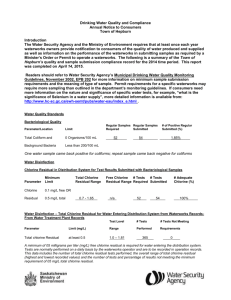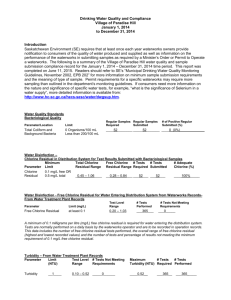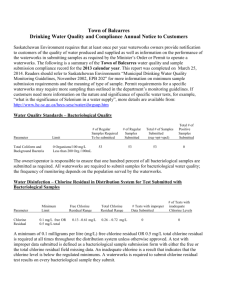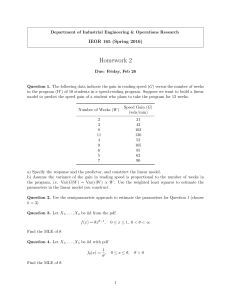Drinking Water Quality and Compliance Town Long Form
advertisement
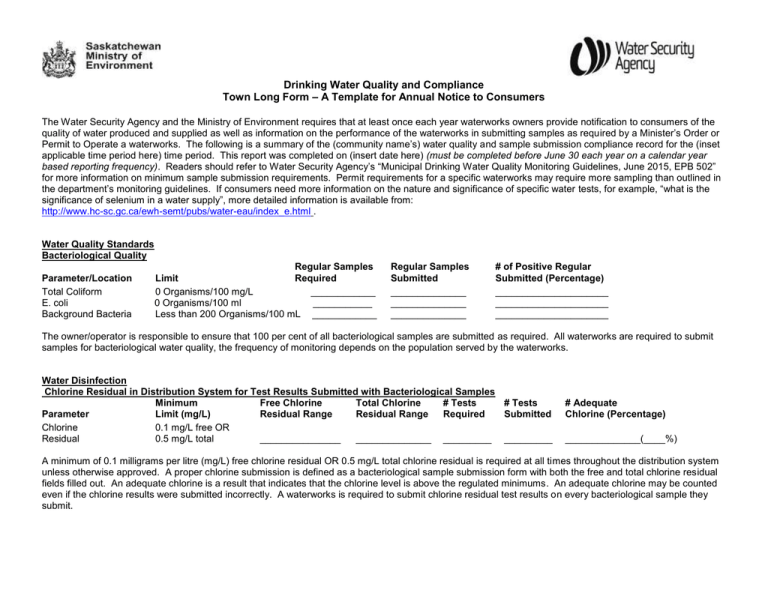
Drinking Water Quality and Compliance Town Long Form – A Template for Annual Notice to Consumers The Water Security Agency and the Ministry of Environment requires that at least once each year waterworks owners provide notification to consumers of the quality of water produced and supplied as well as information on the performance of the waterworks in submitting samples as required by a Minister’s Order or Permit to Operate a waterworks. The following is a summary of the (community name’s) water quality and sample submission compliance record for the (inset applicable time period here) time period. This report was completed on (insert date here) (must be completed before June 30 each year on a calendar year based reporting frequency). Readers should refer to Water Security Agency’s “Municipal Drinking Water Quality Monitoring Guidelines, June 2015, EPB 502” for more information on minimum sample submission requirements. Permit requirements for a specific waterworks may require more sampling than outlined in the department’s monitoring guidelines. If consumers need more information on the nature and significance of specific water tests, for example, “what is the significance of selenium in a water supply”, more detailed information is available from: http://www.hc-sc.gc.ca/ewh-semt/pubs/water-eau/index_e.html . Water Quality Standards Bacteriological Quality Parameter/Location Total Coliform E. coli Background Bacteria Regular Samples Limit Required 0 Organisms/100 mg/L ____________ 0 Organisms/100 ml ___________ Less than 200 Organisms/100 mL ____________ Regular Samples Submitted ______________ ______________ ______________ # of Positive Regular Submitted (Percentage) _____________________ _____________________ _____________________ The owner/operator is responsible to ensure that 100 per cent of all bacteriological samples are submitted as required. All waterworks are required to submit samples for bacteriological water quality, the frequency of monitoring depends on the population served by the waterworks. Water Disinfection Chlorine Residual in Distribution System for Test Results Submitted with Bacteriological Samples Minimum Free Chlorine Total Chlorine # Tests # Tests Parameter Limit (mg/L) Residual Range Residual Range Required Submitted Chlorine 0.1 mg/L free OR Residual 0.5 mg/L total _______________ ______________ _________ _________ # Adequate Chlorine (Percentage) ______________(____%) A minimum of 0.1 milligrams per litre (mg/L) free chlorine residual OR 0.5 mg/L total chlorine residual is required at all times throughout the distribution system unless otherwise approved. A proper chlorine submission is defined as a bacteriological sample submission form with both the free and total chlorine residual fields filled out. An adequate chlorine is a result that indicates that the chlorine level is above the regulated minimums. An adequate chlorine may be counted even if the chlorine results were submitted incorrectly. A waterworks is required to submit chlorine residual test results on every bacteriological sample they submit. Water Disinfection Free Chlorine Residual for Water Entering Distribution System from Waterworks Records-From Water Treatment Plant Records_______________ Parameter Limit (mg/L) Test Level Range # Tests Performed # Tests Not Meeting Requirememts Free Chlorine Residual at least 0.1 _____________ ____________ ______________________________ A minimum of 0.1 milligrams per litre (mg/L) free chlorine residual is required for water entering the distribution system. Tests are normally performed on a daily basis by the waterworks operator and are to be recorded in operation records. This data includes the number of free chlorine residual tests performed, the overall range of free chlorine residual (highest and lowest recorded values) and the number of tests and percentage of results not meeting the minimum requirement of 0.1 mg/L free chlorine residual. Turbidity – From Water Treatment Plant Records Limit Test Level Parameter (NTU) Range Turbidity _______ _________ # Tests Not Meeting Requirements _________________ Maximum Turbidity (NTU) ______________ # Tests # Tests Required Performed __________ ____________ Turbidity is a measure of water treatment efficiency. Turbidity measures the “clarity” of the drinking water and is generally reported in Nephelometric Turbidity Units (NTU). All waterworks are required to monitor turbidity at the water treatment plant. The frequency of measurement varies from daily for small systems to continuous for larger waterworks. Chemical – Health Category Limit Parameter MAC (mg/L) Arsenic 0.010 Barium 1.0 Boron Bromate 0.01 Cadmium 0.005 Chlorate 1.0 Chlorite 1.0 Chromium 0.05 Fluoride (avg.*) 1.5 Lead 0.01 Nitrate (avg.*) 45.0 Selenium 0.01 Uranium 0.02 Limit IMAC (mg/L) 5.0 Sample Results _______ _______ _______ _______ _______ _______ _______ _______ _______ _______ _______ _______ _______ # Samples Exceeding MAC/IMAC _____________________ _____________________ _____________________ _____________________ _____________________ _____________________ _____________________ _____________________ _____________________ _____________________ _____________________ _____________________ _____________________ # Samples Required __________ __________ __________ __________ __________ __________ __________ __________ __________ __________ __________ __________ __________ # Samples Submitted _____________ _____________ _____________ _____________ _____________ _____________ _____________ _____________ _____________ _____________ _____________ _____________ _____________ Substances within the chemical health category may be naturally occurring in drinking water sources or may be the result of human activities. These substances may represent a long-term health risk if the Maximum Acceptable Concentration (MAC) or Interim Maximum Acceptable Concentration (IMAC) is exceeded. All drinking water supplies are required to monitor for substances in the Chemical-Health category, the frequency of monitoring depends on the population served by the waterworks. Some waterworks will add fluoride to drinking water as a means to aid in the prevention of dental decay. Chemical – Trihalomethanes (THMs) and Haloacetic Acids (HAAs) Parameter Limit IMAC (mg/L) Trihalomethanes (THMs) 0.1 Haloacetic Acids (HAAs) 0.080 Sample Result (average) # Samples Required # Samples Required _______________ _________________ ___________ ______________ 4 (one every 3 months) __________ THMs and Haloacetic Acids are generated during the water disinfection process as a by-product of reactions between chlorine and organic material. THMs are generally found only in drinking water obtained from surface water supplies. THMs and HAAs are to be monitored on a quarterly basis and the IMAC result is expressed as an average of 4 quarterly samples. Only water supplies derived from surface water or groundwater under the influence of surface water are required to monitor for THMs and Haloacetic Acids unless otherwise specified in the facility Permit to Operate. General Chemical Parameter Alkalinity Bicarbonate Calcium Carbonate Chloride Conductivity Hardness Magnesium PH Sodium Sulphate Total dissolved solids Aesthetic Objectives* (mg/L) 500 No Objective No Objective No Objective 250 No Objective 800 200 No Objective 300 500 1500 Sample Results (average) ______________ ______________ ______________ ______________ ______________ ______________ ______________ ______________ ______________ ______________ ______________ _______________ # Samples Required __________ __________ __________ __________ __________ ___________ ___________ ___________ ___________ ___________ ___________ ___________ # Samples Submitted ___________ ___________ ___________ ___________ ___________ ___________ ___________ ___________ __________ ___________ ___________ ___________ All waterworks serving less than 5000 persons are required to submit water samples for SE’s General Chemical category once every two years if a ground water source or once per three months every second year if a surface water or blended surface/groundwater source. The General Chemical category includes analysis for alkalinity, bicarbonate, calcium, carbonate, chloride, conductivity, hardness (as CaCO 3), magnesium, sodium, sulphate and total dissolved solids. The last sample for General Chemical analysis was required on (insert year required) and submitted on (insert date) (use this statement if a groundwater supply). The last sets of quarterly samples for General Chemical analysis were required on (insert year or sample submission period required) and were submitted on (insert dates) (use this statement if a surface source or blended source). Sample results indicated that there were no exceedences of the provincial aesthetic objectives for the General Chemical category (use this statement if there were no exceedences). (OR) Samples exceeded provincial aesthetic objectives for the General Chemical category for the following parameters: (use only the applicable portions of the table below for which values have been exceeded). *Objectives apply to certain characteristics of or substances found in water for human consumptive or hygienic use. The presence of these substances will affect the acceptance of water by consumers and/or interfere with the practice of supplying good quality water. Compliance with drinking water aesthetic objectives is not mandatory as these objectives are in the range where they do not constitute a health hazards. The aesthetic objectives for several parameters (including hardness as CaCO3, magnesium, sodium and total dissolved solids) consider regional differences in drinking water sources and quality. Algal Toxins –Microcystin-LR Limit Sample Parameter MAC (mg/L) Results Microcystin LR 0.0015 ________ # Samples Exceeding MAC _____________ # Samples Required ________ Date of last sample: ____________________ # Samples Submitted __________ Microcystin LR is an algal toxin typically released following die-off on an algal bloom in a raw surface water supply. Samples should typically be collected and analyzed on a monthly basis during periods when algae blooms on reservoirs or other surface water sources occur. More information on water quality and sample submission performance may be obtained from: Town/Village/Hamlet/Rural Municipality/Owner Name and Title Postal Address Telephone number/Facsimile number (if available)/E-mail address (if available) (Note: This form may be used for communities or waterworks serving a population of less than 5000 persons.) June 2015 EPB 536C
